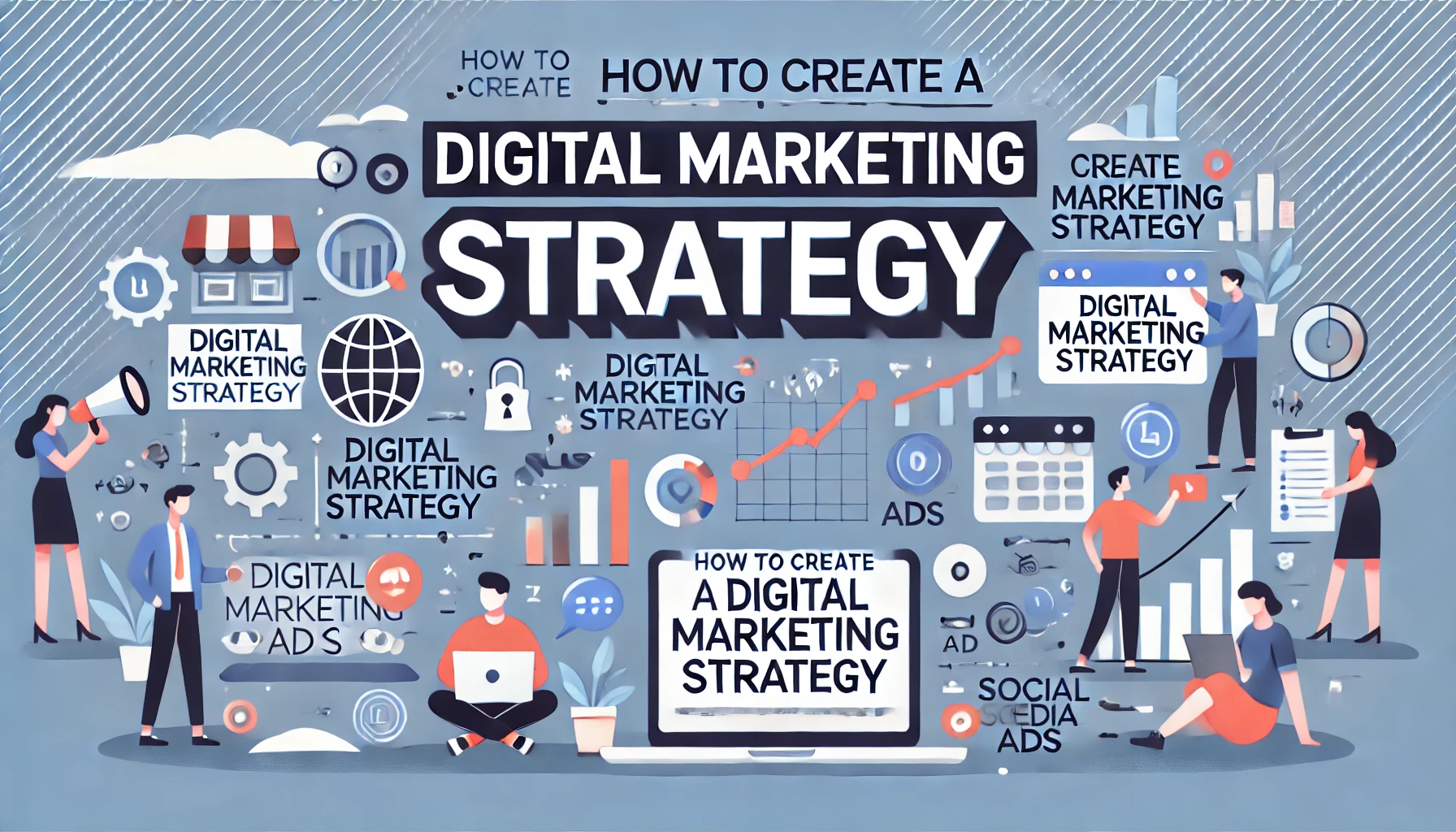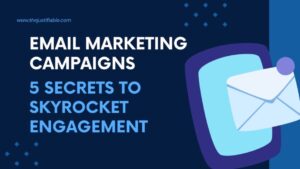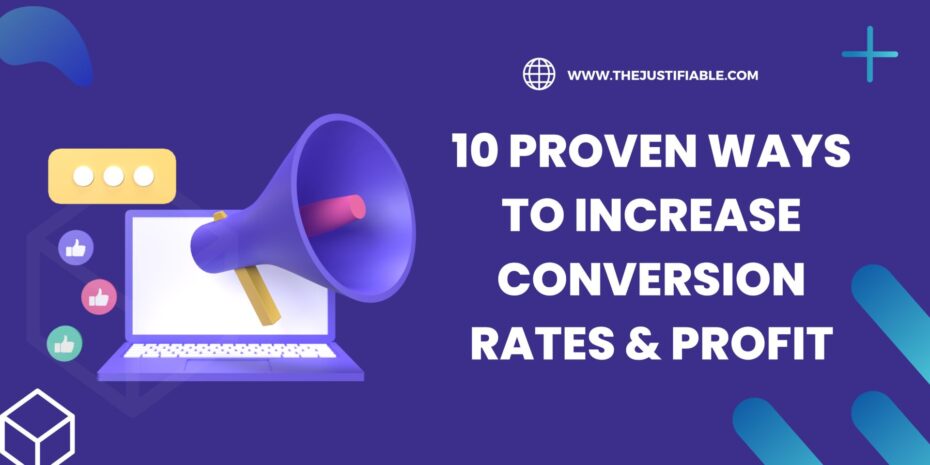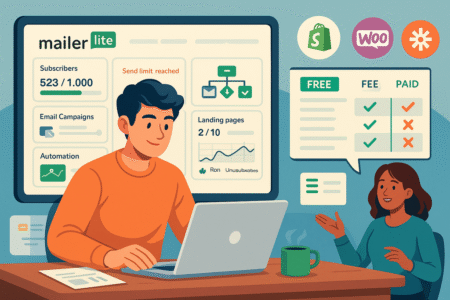Table of Contents
Looking to develop an effective digital marketing strategy? How do you create a plan that truly reaches your audience and achieves your business goals?
In this guide, we’ll explore a step-by-step process for building a winning digital marketing strategy that maximizes reach, engagement, and results.
Understanding Digital Marketing Strategy Basics
A digital marketing strategy is essential for guiding a business’s online efforts. This strategy involves planning and implementing specific digital marketing techniques to reach targeted goals. A solid strategy helps streamline marketing efforts and enhances brand visibility online.
Defining a Digital Marketing Strategy for Success
A successful digital marketing strategy begins with understanding what it aims to achieve. Defining this strategy involves knowing your audience and identifying the best ways to connect with them. I believe that a well-defined plan allows for smoother execution and better results.
By knowing your audience’s preferences, you can create messages that resonate. This connection encourages engagement and trust, key factors for brand growth. A well-structured strategy focuses on reaching these goals in measurable ways, making it adaptable and resilient over time.
Every business’s strategy will vary depending on its niche, but the goal is often the same: connect with the right people at the right time. A clear strategy lets businesses stay on top of changing trends and adjust their approaches as needed.
I recommend keeping your strategy flexible and revisiting it periodically. Digital landscapes evolve, and your approach should too. Defining a strong foundation now sets the stage for lasting success.
Key Components of a Digital Marketing Strategy
A comprehensive digital marketing strategy contains several core components, each contributing to its overall effectiveness. These components often include content marketing, social media, email marketing, and paid advertising. Integrating these elements lets you reach audiences on multiple fronts.
Content marketing involves creating valuable material that informs or entertains, helping build authority in your industry. It’s one of the most effective ways to attract organic traffic. For social media, I suggest identifying platforms where your audience is active, engaging with them regularly to build relationships.
Email marketing helps maintain close communication with subscribers, while paid advertising extends reach quickly. Using these components together strengthens your digital presence, helping maximize the impact of each channel. Remember, the aim is to connect seamlessly across multiple touchpoints.
A balanced digital strategy includes these components without overwhelming your team. Choose what best fits your audience and adapt as your strategy evolves. When done right, each component amplifies the others.
Common Goals in Digital Marketing Strategies
In digital marketing, having clear goals is essential. These goals can range from increasing brand awareness to driving sales or growing your online following. Each goal directs the focus of your marketing efforts, ensuring resources are used effectively.
For example, if your primary goal is brand awareness, content marketing might be the focus. Content builds familiarity with your audience, laying the groundwork for trust. Conversely, if conversions are your goal, then PPC ads or email campaigns could be more effective.
I suggest setting realistic and measurable goals to track progress. This tracking helps pinpoint what’s working and what isn’t. It also allows for adjustments, keeping your strategy on course.
Ultimately, knowing your goals empowers you to allocate resources smartly. Whether it’s reaching new audiences or improving retention, defined goals keep your strategy targeted and impactful.
Why Every Business Needs a Digital Strategy
A digital marketing strategy is crucial in today’s online-driven world. Without a strategy, a business’s online presence can lack direction, making it challenging to achieve meaningful growth. I believe every business benefits from a plan that keeps them focused on their objectives.
This strategy not only improves brand visibility but also makes marketing efforts more cost-effective. With a clear plan, businesses avoid spending on ineffective channels. Instead, they focus on tactics that genuinely work for their audience.
A well-crafted digital strategy provides structure and flexibility, allowing adjustments as needed. This adaptability ensures that a business remains relevant, even as trends shift.
Without a strategy, businesses risk missing out on critical engagement opportunities. A clear digital strategy positions your business to grow sustainably and reach its full potential online.
Setting Clear Goals for Your Digital Strategy

Setting clear goals gives your digital marketing strategy a solid foundation. These goals provide direction, making it easier to plan campaigns and measure their success. When goals align with your business objectives, your marketing efforts drive meaningful results.
SMART Goals and Digital Marketing
SMART goals – specific, measurable, achievable, relevant, and time-bound – are essential for a successful digital marketing strategy. I suggest starting with SMART goals to keep your efforts structured and focused, making success easier to track and celebrate.
Setting specific goals allows you to focus your strategy on tangible outcomes. Measurable goals help track progress, while achievable goals keep expectations realistic. Each goal should be relevant to your overarching business objectives, and time-bound to add urgency.
In digital marketing, I believe that SMART goals lead to more effective campaigns. When goals are clear, it’s easier to determine what’s working and what needs adjustment. You can focus resources on high-impact tactics and refine your approach over time.
A SMART framework gives you a roadmap for success, allowing you to build a digital strategy that adapts as your business grows. This flexibility is key to staying competitive.
Aligning Digital Strategy with Business Objectives
Aligning your digital strategy with business objectives ensures every effort contributes to broader goals. This alignment keeps marketing and business growth on the same track, avoiding wasted resources. I suggest regularly checking that your strategy reflects current business priorities.
For instance, if brand awareness is a business objective, your strategy should emphasize content and social media. This approach raises brand recognition. Alternatively, if revenue growth is the goal, consider strategies that boost conversions, like targeted ads or email sequences.
Having a well-aligned strategy ensures marketing efforts aren’t siloed but support overall business health. This alignment also makes measuring ROI easier, as you’ll clearly see the impact on broader objectives.
Maintaining this alignment requires periodic reviews. As business priorities change, so should your strategy. Keeping everything aligned is key to building a cohesive, successful approach.
Setting Benchmarks for Success Measurement
Setting benchmarks helps gauge progress and measure success within your digital marketing strategy. Benchmarks offer a reference point to track key metrics, making it easier to adjust your approach if results fall short. I recommend establishing clear, relevant benchmarks from the start.
Common benchmarks include website traffic, engagement rates, and conversion rates. Each provides insight into how your strategy performs in different areas. For example, if engagement rates are low, consider revising your content approach to spark interest.
Benchmarks don’t just show what’s working; they also reveal areas needing improvement. Regularly reviewing these benchmarks lets you refine tactics, boosting performance over time.
Having benchmarks keeps your strategy results-driven. You’re not guessing but using data to guide decisions, ensuring the best possible outcomes for your efforts.
Identifying Key Performance Indicators (KPIs)
KPIs are essential for tracking a digital strategy’s effectiveness. These indicators measure how well your strategy achieves its goals. Selecting the right KPIs ensures you focus on impactful metrics, making it easier to refine your approach based on real results.
For example, if your focus is website traffic, page views and bounce rates might be key KPIs. For lead generation, form submissions and email sign-ups could be better indicators. I suggest choosing KPIs that directly reflect your objectives.
KPIs keep your strategy accountable, highlighting what’s working and what needs attention. When KPIs show strong performance, you can double down on effective tactics. Conversely, if results lag, you can adjust tactics to improve.
Regularly reviewing KPIs keeps your strategy agile. It allows for responsive changes that keep your marketing approach aligned with audience preferences and business goals.
Target Audience Research and Segmentation
Understanding your audience is foundational to any successful digital marketing strategy. Knowing who you’re targeting allows you to create more effective campaigns, refine messaging, and engage with the people who matter most to your business.
Identifying Your Ideal Customer Profile
An ideal customer profile (ICP) is a clear outline of your most valuable audience. I suggest starting with basic information—like age, location, and interests. These details help create an accurate picture of whom you’re targeting, shaping marketing efforts effectively.
Building your ICP involves looking at existing customers to spot common traits. This approach makes targeting simpler, allowing you to focus on people who already resonate with your offerings. Remember, knowing your audience boosts engagement and helps achieve measurable results.
Analyzing purchasing behaviors also helps refine your profile. By focusing on what attracts them, you can adjust messaging accordingly, enhancing your chances of successful interactions. An accurate profile ensures your content reaches the right eyes.
I recommend keeping your ICP updated as customer preferences change. This flexibility helps maintain relevance, adapting your approach to fit shifting needs, ensuring your marketing strategy continues to resonate with your core audience.
Using Demographics and Psychographics Effectively
Demographics provide basic data like age, location, or income, while psychographics reveal interests, values, and motivations. I believe using both allows for a well-rounded understanding of your audience, making it easier to tailor content that appeals directly to their preferences.
Start with demographic information to establish general audience characteristics. This foundation makes segmenting audiences simpler, guiding how you address different groups in a way that’s relevant and engaging. With this base, you can move on to psychographics for a deeper view.
Psychographics give insight into why your audience behaves a certain way. Knowing their values and interests allows for personalized content that connects on a deeper level. It’s more than just appealing to their needs—it’s about resonating with their beliefs.
Using these insights together means your content and offers speak directly to the audience’s life context. When content feels personal, engagement rates rise, building a stronger brand relationship that can lead to customer loyalty.
Creating Buyer Personas for Better Targeting
Buyer personas are fictional characters representing key customer groups. I suggest using personas to segment your audience more effectively, as they help tailor messages for specific needs. Each persona encapsulates motivations, challenges, and preferences, guiding marketing decisions.
Creating personas begins with analyzing customer data, from purchasing behavior to feedback. Each persona represents a different part of your audience, offering insights into what each group values most. This data-driven approach keeps marketing relevant and focused.
I advise personalizing content based on each persona. When audiences feel understood, they’re more likely to engage and trust your brand. It also makes content creation simpler since you know precisely whom you’re speaking to and why.
Remember, personas should evolve as your audience does. Update them periodically to ensure they remain accurate, letting you stay connected with audience needs and refine your strategy for continuous engagement.
Importance of Audience Segmentation in Digital Strategy
Audience segmentation involves dividing your target audience into smaller groups based on shared characteristics. I believe segmentation maximizes reach by allowing personalized communication, which improves engagement and conversion rates by delivering content that feels tailor-made.
Segmentation starts with analyzing demographics and behaviors, creating groups based on relevant factors like age, location, or buying habits. This process makes it easier to send the right message to the right people, increasing the chances of meaningful interactions.
I recommend using segmentation to refine your campaigns for each group. For example, a message for younger audiences might emphasize convenience, while one for professionals could highlight productivity. Targeting specific needs helps content resonate more effectively.
Effective segmentation leads to better ROI. When your audience feels personally addressed, they’re more likely to engage, making segmentation essential for a strategy that’s impactful, cost-effective, and efficient.
Choosing the Right Digital Marketing Channels

Selecting the right channels is critical for reaching your audience effectively. Not every platform suits every business, so I recommend evaluating where your audience spends time online to make informed choices that maximize reach and impact.
Social Media Channels: Choosing the Best Fit
Each social media platform serves a unique purpose, and it’s essential to choose channels where your audience is active. I suggest starting with platforms that align with your content style and audience’s preferences to ensure meaningful engagement.
For instance, Instagram and TikTok are ideal for visual content and a younger demographic, while LinkedIn attracts professionals and works well for B2B outreach. Knowing each platform’s strengths helps you match your message to its unique audience.
I advise creating content tailored to each platform’s format. Content that performs on Facebook may not work on Twitter, so adaptability is key. When audiences see content that fits their preferred platform, engagement is likely to increase.
Using multiple channels enhances visibility but requires balance. Avoid spreading too thin by focusing on a few platforms initially. Expanding as you grow ensures quality engagement and a cohesive brand presence across all channels.
Leveraging SEO for Organic Traffic
SEO drives organic traffic by optimizing content for search engines. I recommend starting with keyword research to understand what your audience searches for. Well-optimized content brings your site into view, attracting users who are actively interested in what you offer.
Creating SEO-friendly content means integrating keywords naturally. I suggest focusing on high-value, low-competition keywords for maximum visibility. Quality content, structured well, captures readers’ attention and improves ranking.
On-page elements like headers, meta descriptions, and internal links further enhance SEO. Each component signals relevance to search engines, helping improve visibility. Optimized content reaches more people, attracting consistent, relevant traffic.
Tracking your SEO performance is crucial. Use analytics to monitor keyword success, adjusting as needed. Adapting to search trends keeps your strategy effective, bringing long-term value by continuously drawing interested audiences.
Email Marketing as a Personal Outreach Tool
Email marketing provides a direct line to your audience, making it personal and effective. I suggest segmenting your email list to send targeted content that matches subscribers’ interests, creating a personalized experience that resonates well.
Creating valuable content in emails keeps subscribers engaged. Share useful insights, exclusive offers, or updates to nurture relationships. When your emails provide value, subscribers are more likely to open, engage, and stay subscribed.
Automating email sequences allows timely responses based on user actions, like sign-ups or purchases. I recommend automation for efficiency and consistency, ensuring no opportunity for engagement is missed. It’s a proactive way to maintain communication.
Measuring email performance informs improvements. Track open rates, click-throughs, and conversions to see what resonates. This data-driven approach ensures emails remain relevant, helping maintain a strong relationship with your audience.
Paid Advertising and PPC for Targeted Reach
Paid ads provide a quick, targeted way to reach potential customers. I suggest using PPC (pay-per-click) advertising on platforms like Google or Facebook to expand reach. With PPC, you target specific groups, ensuring your ads reach people with relevant interests.
Creating compelling ads is key. Use attention-grabbing visuals and clear calls to action to encourage clicks. Target ads to user demographics, locations, or interests to maximize relevance, ensuring you connect with the right audience.
Setting a budget and monitoring spending keeps costs manageable. I recommend adjusting bids based on performance, focusing on high-return keywords. This approach optimizes ad spend, helping drive the best possible results.
Tracking ad performance is essential. Metrics like click-through rate and conversion rate show what’s effective, guiding adjustments. When ads are tailored to user needs, they’re more likely to convert, making PPC a valuable tool in your strategy.
Integrating Content Marketing in Your Strategy
Content marketing creates value for your audience, driving engagement and building authority. I believe integrating content across all channels boosts visibility, positioning your brand as a reliable resource in your industry.
Content includes blogs, videos, guides, and infographics. I suggest using a mix to keep audiences engaged. Each type offers unique benefits, like videos for quick insights or blogs for in-depth information, catering to various user preferences.
Sharing content on social media and email broadens reach. When audiences find valuable information, they’re more likely to share it, expanding visibility naturally. Content sharing builds credibility, showing your audience you understand their needs.
Optimizing content for SEO enhances its visibility. I recommend using keywords thoughtfully and structuring posts for readability. SEO-friendly content attracts organic traffic, bringing steady attention to your brand without requiring paid promotion.
Crafting a Content Marketing Plan
Creating a content marketing plan provides structure to your digital marketing strategy. This plan ensures your content aligns with business goals, remains consistent, and resonates with your audience, ultimately driving engagement and building brand authority.
Content Creation Aligned with Your Brand Voice
Your brand voice sets the tone for all your content. I recommend defining a voice that reflects your brand’s values, personality, and goals. This consistency helps audiences recognize your content across platforms, strengthening your brand identity.
Each piece of content should reflect this voice. Whether you’re writing blog posts, social media updates, or emails, your brand’s voice should remain consistent. This consistency builds trust and makes your brand more memorable to your audience.
Incorporating your brand voice also means adapting it slightly for different platforms. A professional tone might work for LinkedIn, while a casual one fits Instagram. Adjusting while staying true to your voice enhances engagement.
Remember, a clear and distinctive voice sets your brand apart. I suggest revisiting your brand voice periodically to ensure it still aligns with your goals and resonates with your evolving audience.
Planning a Content Calendar for Consistency
A content calendar helps maintain a steady flow of posts, avoiding last-minute rushes. I suggest using a calendar to map out content types, themes, and publication dates. This approach keeps your messaging organized and ensures regular audience engagement.
Consistency strengthens your presence, showing your audience you’re reliable. A calendar helps plan posts in advance, reducing stress and ensuring that each piece aligns with your overall strategy. It’s a practical tool for keeping content cohesive.
Your calendar should cover various formats, from blog posts to social media. I recommend spacing out different formats to keep content diverse and engaging. This variety maintains audience interest and addresses different preferences.
Using a calendar also allows room for timely updates. If there’s a trend or relevant event, you can adjust your content accordingly. Flexibility within a structured plan keeps your content both timely and relevant.
Optimizing Content for SEO Performance
Optimizing content for SEO makes it easier for your audience to find you. I recommend starting with keyword research to identify terms that matter to your audience. Incorporate these keywords naturally to improve visibility without sacrificing readability.
SEO-optimized content includes well-structured headings, meta descriptions, and internal links. These elements signal relevance to search engines, helping boost rankings. I believe a solid SEO strategy enhances both user experience and search engine visibility.
It’s also essential to optimize images and other media. Alt text helps search engines understand content, while compressed images improve page load times. Faster sites retain visitors, enhancing overall engagement and SEO performance.
Regularly updating content keeps it fresh and relevant. Search engines prioritize updated information, so reviewing and refining posts over time is a strategy I recommend for sustained visibility and improved rankings.
Content Types and Formats to Engage Audiences
Different content formats appeal to different audience preferences. I suggest using a mix, from articles and videos to infographics and guides, to cater to varied interests. Diverse formats keep content fresh and help capture attention.
Blog posts are great for in-depth explanations, while videos engage visually and simplify complex topics. I believe mixing formats strengthens your reach, as each type attracts a different audience segment and enhances overall engagement.
Infographics work well for presenting data in a visually appealing way. They’re easily shareable, increasing your content’s reach. Guides and eBooks, on the other hand, offer valuable resources, building your authority in the process.
I recommend testing different formats to see what resonates most. Analyzing engagement metrics helps refine your approach, ensuring your content consistently captures attention and adds value for your audience.
Building a Social Media Marketing Strategy

A social media marketing strategy maximizes your online visibility, engaging audiences on platforms they already use. I advise choosing platforms that align with your audience’s preferences to make the most of your efforts and build lasting connections.
Selecting Platforms That Match Your Audience
Choosing the right social media platforms is key to reaching your audience effectively. I suggest researching where your audience spends their time and selecting platforms accordingly. This choice ensures your efforts resonate and attract genuine engagement.
For example, younger audiences might prefer TikTok or Instagram, while professionals are active on LinkedIn. Knowing these preferences helps tailor your content, making it relevant to each platform. The right choice strengthens your connection with users.
I advise focusing on a few platforms initially. Quality over quantity ensures you can dedicate time to meaningful interactions, building a solid following. Expanding to more platforms can follow once you’ve established a consistent presence.
Adapting content to each platform’s format is crucial. What works on Twitter might not on Facebook. Tailoring your posts shows your understanding of platform dynamics, boosting engagement and helping your message resonate.
Developing Engaging Social Media Content
Engaging content is the backbone of a successful social media strategy. I recommend creating posts that are informative, entertaining, or visually captivating. Content that provides value to your audience encourages them to like, share, and interact with your brand.
Visuals are essential on social media. High-quality images, videos, or graphics capture attention and make your posts stand out. I suggest investing in eye-catching visuals that reflect your brand and maintain audience interest.
Storytelling also plays a role. Narratives that reflect real-life experiences or customer success inspire engagement. Audiences enjoy relatable content, so sharing stories connects them emotionally, enhancing brand loyalty.
Incorporating interactive elements like polls or quizzes adds a dynamic touch. Interactive content invites participation, making your audience feel involved. Engagement increases when followers can actively respond, strengthening their connection to your brand.
Leveraging Analytics for Social Media Insights
Social media analytics reveal what’s working and what isn’t. I suggest using platform insights to understand audience behavior, engagement levels, and content performance. Data-driven adjustments improve strategy effectiveness, aligning posts with audience preferences.
Metrics like reach, impressions, and engagement rates show which posts resonate most. By identifying high-performing content, you can focus on topics and formats that draw attention. This insight maximizes impact, letting you create content that consistently engages.
Audience insights offer clues about optimal posting times. Timing affects visibility, so I recommend experimenting with post schedules to see what works best. Regularly checking analytics keeps your approach sharp and results-driven.
Monitoring follower growth and demographics refines targeting. Knowing who engages with your content helps tailor future posts, making them relevant and engaging. This continual refinement strengthens your connection with followers.
Engaging and Growing Your Social Media Community
Building a community involves more than posting—it requires interaction. I suggest responding to comments, answering questions, and showing genuine interest in followers’ feedback. Engaging consistently builds trust and fosters a sense of belonging among followers.
Prompt responses to comments or messages show your brand is approachable. I believe this responsiveness encourages followers to interact more frequently, creating a vibrant, active community. Engaged communities often lead to higher loyalty and retention.
Hosting live sessions or Q&As enhances community interaction. These sessions offer a chance for real-time conversations, making followers feel valued. I recommend using such events to connect directly and strengthen relationships.
Celebrating followers’ achievements or sharing user-generated content builds a stronger community bond. When followers feel recognized, they’re more likely to stay connected, participate actively, and support your brand’s growth organically.
Implementing Email Marketing Effectively
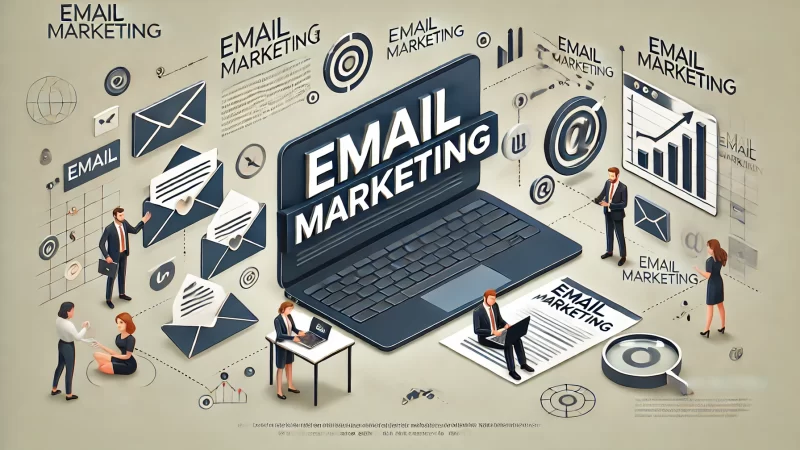
Email marketing allows direct communication with your audience, delivering personalized messages that encourage engagement. I recommend focusing on building a quality email list, crafting relevant campaigns, and utilizing automation to maximize impact and efficiency.
Building a Targeted Email List
A well-curated email list is the foundation of effective email marketing. I suggest using sign-up forms on your website and social media, offering valuable incentives like discounts or free resources. This approach attracts people genuinely interested in your offerings.
Segmenting your list based on user preferences further enhances engagement. When emails cater to specific interests, subscribers feel valued and are more likely to interact. This level of personalization helps you build a loyal and responsive audience.
Another effective strategy involves collaborating with influencers or partners to expand reach. Promoting sign-ups through trusted voices increases credibility, bringing in high-quality leads who trust your brand.
I recommend periodically cleaning your email list by removing inactive subscribers. This practice keeps your list focused and engaged, improving open rates and deliverability, ensuring your emails reach those who value your content.
Crafting Compelling Email Campaigns
Creating engaging emails starts with a captivating subject line that grabs attention. I advise using concise, relevant language that sparks curiosity. An interesting subject line encourages subscribers to open the email, making it the first step in successful engagement.
The email body should be informative and visually appealing. Using bullet points, images, and short paragraphs makes content digestible. I recommend including a clear call-to-action (CTA) that directs readers towards your desired outcome, like visiting your website.
Personalization is key in email marketing. Addressing recipients by name or tailoring content to their interests enhances relevance. When subscribers feel understood, they’re more likely to engage, boosting campaign success rates.
Consistency in tone and timing builds familiarity. I suggest setting a regular schedule so subscribers know when to expect your emails. A predictable cadence fosters a relationship, making readers look forward to your updates.
Automating Email Sequences for Efficiency
Email automation saves time and ensures timely communication. I recommend setting up automated welcome sequences for new subscribers, introducing them to your brand and keeping them engaged from the start. A warm welcome builds a strong foundation.
Drip campaigns are useful for nurturing leads over time. By delivering information in stages, you guide subscribers through the decision-making process, increasing the likelihood of conversions. This gradual approach builds trust without overwhelming readers.
Triggered emails based on actions, like abandoned cart reminders, boost engagement. These emails are highly relevant as they respond to user behavior, showing you understand their needs. I advise using triggered emails to re-engage potential customers.
Analyzing automated sequences helps refine your approach. Tracking performance metrics like open rates and click-through rates allows adjustments for better results, ensuring your automated emails remain effective and aligned with user preferences.
Measuring and Optimizing Email Campaign Results
Tracking email metrics is crucial for improving performance. I suggest monitoring open rates, click-through rates, and conversions to see what resonates. These insights reveal which strategies work best, guiding adjustments to enhance future campaigns.
A/B testing is a powerful tool for refining campaigns. I recommend experimenting with different subject lines, email layouts, or CTAs to see what yields the highest engagement. Testing reveals what your audience prefers, helping you tailor emails effectively.
Understanding subscriber behavior through analytics informs better decisions. For instance, knowing when users open emails helps optimize timing, improving open rates. Adjusting send times can significantly boost engagement and overall campaign success.
I advise regularly reviewing campaign performance and refining tactics. Email marketing is dynamic, so continuous optimization ensures messages remain relevant, keeping subscribers interested and improving your return on investment.
Utilizing Paid Advertising and PPC
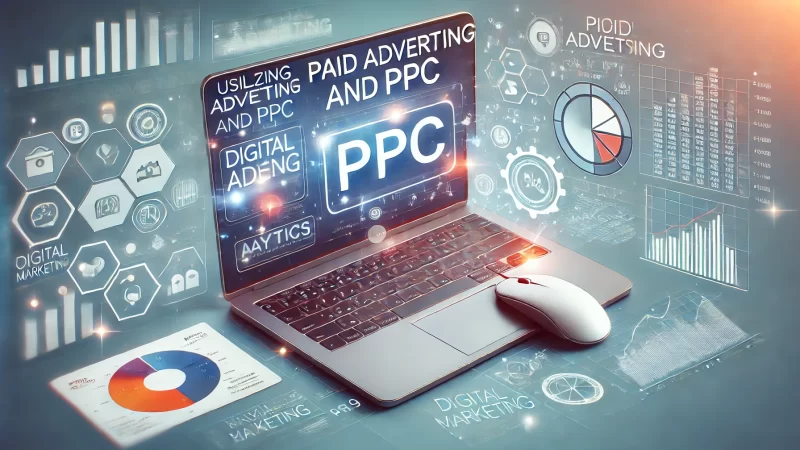
Paid advertising accelerates brand visibility by targeting specific audiences directly. I recommend using PPC to reach potential customers effectively, as these ads appear to users actively searching for your products or services, making them highly relevant and impactful.
Choosing PPC Platforms for Your Strategy
Different PPC platforms offer distinct advantages. I suggest choosing platforms where your audience is active. Google Ads is ideal for broad reach, while Facebook Ads work well for demographic targeting. Knowing platform strengths helps maximize effectiveness.
LinkedIn Ads target professionals, making them ideal for B2B campaigns. Instagram Ads are visual-focused, appealing to younger audiences. Each platform’s unique user base offers opportunities to connect with specific segments, enhancing ad relevance.
I advise testing multiple platforms to see where you get the best results. Performance varies across platforms, so testing helps identify where your target audience engages most. A tailored approach ensures ad spend is directed efficiently.
Platform choice should align with your campaign goals. Google Ads may suit sales-driven campaigns, while social media ads work well for brand awareness. Selecting the right platform ensures your PPC efforts align with business objectives.
Setting and Managing PPC Budgets
Budget management is essential in PPC to maximize ROI. I suggest starting with a modest budget and adjusting based on performance. Setting limits ensures you avoid overspending, allowing a controlled approach while you gauge ad effectiveness.
Daily budget limits help manage spending, especially when starting. This approach provides flexibility, allowing adjustments without major financial risks. I recommend tracking spending closely, refining budgets based on what performs best.
Using bid strategies helps control costs. Strategies like cost-per-click (CPC) or cost-per-acquisition (CPA) let you focus spending on specific actions, optimizing budget use. Each bid strategy serves different goals, so choose based on desired outcomes.
Periodically reviewing ad spend and reallocating budgets enhances results. Redirecting funds to high-performing ads maximizes returns, ensuring each dollar works harder. Effective budget management is key to sustainable PPC success.
Best Practices for Creating High-Converting Ads
Creating high-converting ads starts with a clear, enticing message. I suggest focusing on benefits rather than features, showing audiences how your product meets their needs. This customer-focused approach increases the likelihood of clicks and conversions.
Using strong visuals captures attention quickly. I recommend incorporating high-quality images or videos that represent your brand and product well. Engaging visuals make ads memorable, encouraging users to learn more.
A compelling CTA drives action. Phrases like “Get Started” or “Learn More” invite engagement. I advise using clear, direct language that tells users exactly what to do next, making the desired action easy to understand.
Testing ad variations provides insights. Experiment with different headlines, visuals, and CTAs to see what resonates. Regular testing refines your approach, ensuring ads remain effective and appealing to your target audience.
Tracking ROI and Performance in Paid Campaigns
Measuring PPC performance is crucial for optimizing ROI. I suggest monitoring metrics like click-through rate (CTR), conversion rate, and cost-per-click (CPC). These indicators show ad effectiveness, guiding adjustments to maximize returns.
Analyzing which keywords perform best improves targeting. I recommend regularly reviewing keyword performance to refine your focus on high-impact terms, ensuring your ads reach the most relevant audience and improve ROI.
Conversion tracking reveals what drives results. Setting up tracking shows the actions users take after clicking, helping you understand ad effectiveness. This insight allows for strategic adjustments to boost conversion rates.
I advise using data to make informed adjustments. PPC campaigns benefit from continuous refinement, as small tweaks based on performance data can significantly improve results, maximizing the value of each ad dollar spent.
Analyzing and Refining Your Strategy Over Time
Regular analysis keeps your digital marketing strategy relevant and effective. I recommend consistently evaluating performance metrics to make data-driven improvements, ensuring that your strategy adapts to shifting trends and audience preferences.
Tools for Tracking Digital Marketing Metrics
Tracking tools like Google Analytics and SEMrush provide insights into website and campaign performance. I suggest using these tools to monitor visitor behavior, traffic sources, and engagement metrics, allowing for a comprehensive view of your digital marketing success.
Social media analytics offer platform-specific data. Tools like Facebook Insights or Twitter Analytics reveal engagement and follower growth, guiding social media strategy adjustments. These insights help ensure each platform contributes to overall goals.
Email marketing platforms like Moosend offer built-in analytics, tracking open rates, clicks, and conversions. I advise using these metrics to refine email strategies, making each message more effective at reaching and engaging subscribers.
Using multiple tools provides a well-rounded perspective. Each tool offers unique insights, so combining them enhances your understanding of digital performance, enabling precise, impactful improvements.
How to Interpret Data for Better Decisions
Interpreting data turns raw metrics into actionable insights. I suggest looking beyond surface numbers to understand user behavior and patterns. For instance, high bounce rates could indicate content misalignment, signaling a need for adjustments.
Identifying trends helps pinpoint what resonates with your audience. If certain posts or campaigns consistently perform well, consider amplifying similar content. I believe recognizing successful patterns enhances strategy focus, boosting overall engagement.
Data interpretation informs timing adjustments. Knowing peak engagement periods lets you post when audiences are most active. This optimization increases visibility, enhancing your strategy’s impact with minimal effort.
Using data for decision-making keeps your approach adaptable. I recommend regular data analysis to fine-tune your tactics, ensuring your strategy evolves based on proven results rather than assumptions.
Adjusting Your Strategy Based on Performance
Adjusting your strategy ensures ongoing relevance and effectiveness. I suggest reviewing performance metrics regularly to spot areas for improvement. This approach allows for proactive adjustments, keeping your strategy aligned with audience needs.
Testing new tactics based on performance insights enhances results. If a certain format or channel works well, consider expanding its use. Experimentation drives growth, letting you refine your strategy over time for better outcomes.
Adjustments should reflect changes in audience behavior. As interests evolve, so should your approach. I recommend staying in tune with your audience to ensure your content remains engaging and valuable.
Regular strategy reviews prevent stagnation. Minor tweaks based on current data can have a significant impact, ensuring your strategy continuously meets its objectives in a dynamic digital landscape.
Importance of Continuous Optimization
Continuous optimization is key to a resilient strategy. I believe that consistent improvements, based on data, enhance performance and relevance. Refining tactics regularly keeps your strategy competitive, allowing you to meet goals efficiently.
Each optimization brings insights that improve future efforts. I recommend viewing each change as a learning opportunity, enhancing your understanding of what drives success. This proactive approach ensures consistent progress and improvement.
Optimization extends to all aspects of digital marketing, from SEO to PPC. When each element is refined over time, the combined effect strengthens your overall strategy, creating a solid foundation for growth.
Regular optimization keeps your strategy adaptable. As trends shift, fine-tuning your approach allows you to stay aligned with audience needs, ensuring that your digital marketing efforts remain effective and impactful.
Frequently Asked Questions (FAQs)
What is a digital marketing strategy?
A digital marketing strategy is a plan to reach, engage, and convert online audiences using digital tools like social media, SEO, and email marketing.
How do I create a digital marketing strategy for my business?
Begin by defining your audience and goals, then select the channels (like social media, email, and PPC) that best reach your target. Track and refine as you go.
Why is audience research essential in digital marketing?
Audience research helps identify the preferences, needs, and behaviors of your target group, making your messaging more relevant and effective.
What are the key components of a digital marketing strategy?
Components often include content marketing, SEO, social media, email campaigns, and paid advertising to reach and engage your target audience.
How often should I update my digital marketing strategy?
I suggest reviewing your strategy quarterly or when new market trends arise. Frequent updates ensure it remains relevant and effective.
What tools can I use to track my digital marketing performance?
Google Analytics, SEMrush, and social media insights provide data on audience behavior, engagement, and website traffic to measure success.
How can I set realistic goals for my digital marketing?
Use SMART goals (Specific, Measurable, Achievable, Relevant, Time-bound) to create clear and attainable marketing objectives aligned with business needs.
Which digital marketing channels are most effective?
Effectiveness depends on your audience; popular channels include social media, SEO, email marketing, and paid ads. Start with platforms your audience uses.
What’s the role of SEO in a digital marketing strategy?
SEO increases website visibility in search engine results, driving organic traffic and enhancing brand authority through optimized content.
How do I choose the best social media platform for my brand?
Identify where your audience is most active. LinkedIn suits B2B, while Instagram or TikTok engage younger audiences.
How can email marketing support my digital marketing goals?
Email marketing nurtures leads with personalized, targeted messages, helping to build customer loyalty and encourage repeat engagement.
What is audience segmentation, and why is it important?
Audience segmentation divides your audience into groups based on demographics, behaviors, or interests to personalize communication and improve engagement.
How do I measure the ROI of my digital marketing strategy?
Track key metrics like conversions, click-through rates, and cost-per-acquisition to understand your returns and refine your approach.
What are buyer personas, and how do they enhance digital marketing?
Buyer personas represent your ideal customers, providing insights into their needs, motivations, and challenges to shape your messaging effectively.
What’s the best way to adjust a digital marketing strategy over time?
Use data insights to identify trends, refine tactics, and pivot your strategy as needed to keep it aligned with audience behavior and industry trends.


